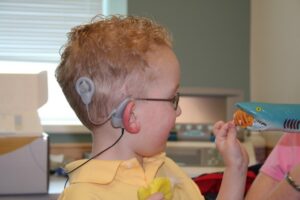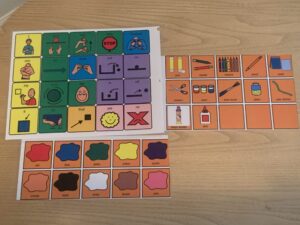Assistive technology is any device or software that helps students with disabilities overcome their learning challenges and develop their skill sets. With individualized lesson plans and assistive technologies, all students, regardless of their unique learning challenges, can benefit equally from a high-quality education. I believe that by altering the general education curriculum with assistive technology—either software or hardware—schools can make it possible for students with disabilities to participate in it, therefore improving the quality of education for all special needs young children. Teachers typically search for novel ways to help students understand the context of the material being taught. With the assistance of assistive technology, students with disabilities might be able to go around or avoid their learning challenges.

Using assistive technology in my experience
As an ECE (Early Childhood Educator) in a daycare organization, I have the privilege of witnessing the remarkable journey of a 5-year-old child who is deaf by birth and relies on special ears to perceive vibrations. Each day, he engages with his peers, exploring the world through the unique lens of his assistive technology. Whether it’s participating in classroom activities or interacting with friends, his special ears serve as a gateway to communication and learning. I’ve observed moments of joy as he delights in the melodies of music and the rhythms of his surroundings, all made possible by these technologies. Through his experiences, it’s clear how assistive technologies play a pivotal role in his development. Not only do they enhance his language skills, but they also boost his confidence, allowing him to navigate his environment with increasing independence. By highlighting these instances of empowerment, we can truly appreciate the profound impact of assistive technologies in creating inclusive and supportive learning environments for children with diverse needs. Through his journey, readers gain a deeper understanding of these tools’ importance in unlocking every child’s potential.
 I learned about several new assistive technology tools during the presentation, which were previously unfamiliar to me.
I learned about several new assistive technology tools during the presentation, which were previously unfamiliar to me.
Immersive Reader, developed by Microsoft, stands out as a potent tool aimed at enriching reading comprehension for individuals of all ages and abilities. This multifaceted tool offers an array of features tailored to support its users in various ways. One such feature is Text-to-Speech, which seamlessly converts written text into spoken words, enabling users to listen to the content being presented. Moreover, Immersive Reader allows for Text Customization, granting users the flexibility to adjust font size, spacing, and background color to suit their reading preferences, thereby enhancing readability. The tool further aids in word recognition through Syllable Highlighting, visually emphasizing individual syllables as they are spoken. Notably, Immersive Reader goes beyond mere text interpretation by providing Parts of Speech Labeling, assisting users in identifying nouns, verbs, adjectives, and other linguistic components for a deeper understanding of language structure. Additionally, the inclusion of a Picture Dictionary offers visual representations of words, facilitating vocabulary comprehension. Widely adopted in educational settings, Immersive Reader serves as a valuable aid for students grappling with reading difficulties, dyslexia, or individuals endeavoring to learn a new language. Its versatility and comprehensive support make it an indispensable resource in fostering inclusive and effective learning environments.
The C-Pen, also known as a “Pen Scanner,” emerges as a portable and innovative tool designed to facilitate reading accessibility for users. This compact device enables individuals to effortlessly scan printed text from a variety of sources such as books, documents, or worksheets. Once scanned, the C-Pen swiftly converts the text into spoken words through its Text-to-Speech functionality, offering users an auditory rendition of the content for enhanced comprehension. Additionally, some models of the C-Pen come equipped with Translation capabilities, allowing users to access text in various languages, thereby promoting language learning and cross-cultural communication. An added feature of the C-Pen is its capability for Audio Recording, enabling users to save the scanned text as an audio file for future reference or study purposes. Particularly beneficial for students with dyslexia, visual impairments, or those facing challenges with reading printed materials, the C-Pen serves as a valuable assistive technology tool. Its portability, ease of use, and diverse functionalities make it an invaluable asset in empowering individuals to access and engage with written content effectively, regardless of their reading abilities or language proficiency.

CoreBoard, is a specialized keyboard designed for those with motor or cognitive disabilities. Its basic layout reduces complexity, while Word Prediction speeds up typing and minimizes errors. Users can customize settings like font and key size. Beneficial for conditions like cerebral palsy, it aids those with typing challenges.
Fringe Board, also known as Periphery Board, is an assistive tool for individuals with limited motor skills. Featuring Large Buttons, it aids those with reduced dexterity by offering easier operation. Visual cues like pictures or symbols on buttons represent words, enhancing communication for conditions such as cerebral palsy or muscular dystrophy. Fringe Board enables effective communication and interaction.

Challenges of assistive technologies
Professionals implementing assistive technology face several challenges:
- Cost: Many tools are expensive with limited funding available.
- Expertise and Training: Requires expertise to find suitable tools for students and time to train teachers, parents, and assistants.
- Resistance to Change: Some team members may resist adopting new technology.
- Investment: It demands time, money, and effort, which can be overwhelming for families.
- Technical Issues: Potential for technology-related problems affecting usage and effectiveness.
In conclusion, assistive technology holds immense potential in supporting children with special needs. It serves as a valuable tool for those who struggle to articulate their thoughts through traditional means, offering avenues for clearer expression through computers and communication devices. Students utilizing assistive technologies often experience enhanced comprehension of learning material, improved communication skills, better social interactions, and heightened cognitive development. However, various challenges such as high costs, limited accessibility, and potential drawbacks hinder the widespread adoption of these technologies. It is my belief that educators, administrators, and parents should carefully consider and implement technologies that cater to the unique needs and learning abilities of each child with disabilities. By doing so, education can become more relevant, meaningful, and inclusive for all students.

Navneet your blog is well planned with all technologies listed as pointers and then challenges so it makes it very easy to understand this post. I like the phrase “unique Needs” more than disabilities because unique needs make it a tool for each one of us in some way. Liker reading it. Very informative
Hi Navneet!
Your blog post on assistive technologies is quite enlightening, emphasizing the enormous influence these tools have in building inclusive learning environments. Your personal tale of the 5-year-old child with a hearing impairment brilliantly demonstrates how assistive technology enables children to fully participate in their education, promoting independence and confidence. Furthermore, your thorough examination of numerous assistive technology tools, such as Immersive Reader, CoreBoard, and Fringe Board, demonstrates a thorough awareness of the diverse requirements of students with disabilities and the innovative solutions available to meet them. Your recognition of the problems associated with deploying assistive technology, combined with practical advice for overcoming them, demonstrates a thoughtful and solution-oriented approach. Overall, your blog post is a useful resource for educators, administrators, and parents looking to provide inclusive educational experiences for all students. Well done!